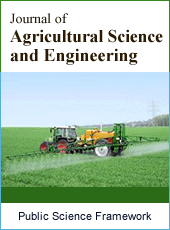Journal of Agricultural Science and Engineering
Articles Information
Journal of Agricultural Science and Engineering, Vol.5, No.2, Jun. 2019, Pub. Date: Apr. 27, 2019
Impact of Climate Change on Crop Water Requirements for Abu-Sabeen Forage Sorghum (Sorghum bicolor L.) and Alfalfa (Medicagosativa L.) in Khartoum State, Sudan
Pages: 36-40 Views: 2357 Downloads: 883
[01]
Hussien Elshareef Elamin, Department of Agricultural Engineering, Faculty of Agriculture, University of Khartoum, Khartoum, Sudan.
[02]
Abdelmoneim Elamin Mohamed, Department of Agricultural Engineering, Faculty of Agriculture, University of Khartoum, Khartoum, Sudan.
[03]
Amir Mustafa Abdeldaim, Department of Agricultural Engineering, Faculty of Agriculture, University of Khartoum, Khartoum, Sudan.
This study was carried out to assess the climate change impact on crop water requirement (ETc) of the main fodder crops grown in Khartoum State, Alfalfa and Sorghum (Abu-Sabeen). Daily meteorological data for the period 1988-2017 were collected from Sudan Meteorological Authority (SMA); temperature, humidity, wind speed, sunshine hours and rainfall data. Reference evapotranspiration (ETo) was determined using mean monthly meteorological data with help of CROPWAT 8.0 software package, which uses the FAO Penman-Monteith procedure and then crop water requirement (ETc) was determined. Statistical Analysis System Software (SAS) was used to analyze the data. The results indicated decreasing trends in relative humidity (RH%) and the opposite holds true for temperature and wind speed, with marked fluctuations in rainfall. Accordingly, ETo (mm/day) increased by 23%, ETc increased by 64% for Alfalfa of the second cutting (1734 m3/ha in 1988 and 2845 m3/ha in 2017), 26% for Abu-Sabeen forage (4935 m3/ha in 1988 and 6212 m3/ha in 2017). It was concluded that ETo values were significuntly (P ≤ 0.05) different, ETc followed the same trend of ETo and in the rainy seasons irrigation requirements were affected by effective rain. Results showed rising demand of water requirement for fodder crops from 1988 to 2017 due to climate change – decrease in RH%, increase in temperature and wind speed and fluctuations in rainfall. The study recommends taking in consideration the impact of climate change in supplying irrigation water for forage crops and irrigation management according to the growth stage of the crop and season.
Climate Change, CROPWAT 8.0, SAS, ETo, ETc, Crop Irrigation Requirement
[01]
Adam, H. S. (2014). Agroclimatology, Crop Water Requirement and WaterManagements. Water management and irrigation institute- University of Gezira-Wad Madani- Sudan.
[02]
Beyazgul, M.; Kayam, Y. and Engelsman, F. (2000). Estimation methods for crop requirements in the Gediz Basin of Western of Turkey. Journal of Hydrology, 229 (1-2): 19-26.
[03]
Demir, D. O.; Howel, T. A.; Buyukcangaz, H.; Turan, Z. M. and Koksal, Z. E. (2006). Deficit irrigation of sunflower in sub-humidclimate. Irrig. Sci. 24, 279-289.
[04]
El-siddig, K.; Gebauer, J.; Dawoud, H. and Burkert, A. (2006). The status of urban andperi-urban agriculture (UPA) of Khartoum State, Sudan.
[05]
FAO (2006). Evapotranspiration. Irrigation and drainage paper no. 56. Food and Agricultural Organization of United Nations. Rome, Italy.
[06]
Lee, J. and Huang, W. (2014). Impact of climate change on the irrigation water requirement in Northern Taiwan. Department of Harbor and River Engineering, National Taiwan OceanUniversity, Keelung 20224, Taiwan.
[07]
Manasa, H. G. and Shivapur, A. V. (2016). Implications of climate change on crop water requirements in HukkeriTaluk of BelagaviDistrict, International Journal of Research in Engineering and Technology (IJRET), ISSN: 2319-1163, p ISSN: 2321-7308, Karnataka, India.
[08]
Mohammed, M. I. (2012). Animal production in Khartoum State the impediments and solutions, (in Arabic) published insudaforage. blogspot. com.
[09]
Parekh, F. and Prajapati, K. P. (2013). Climate change impacts on cropwater requirement for Sukhi reservoir project. International Journal of Innovative Research in Science, Engineering and Technology, Vol. 2, Issue 9, September 2013. India.
[10]
Rao, V. U. M.; Subbarao, Abburi.; Rao, G. G. S. N.; Satyanarayana, T.; Narayanan, Manikandan and Venkateshwarlu, B. (2011). Impact of Climate Change on Crop Water Requirements and Adaptation Strategies. 10. 1007/978-3-642-19360-6_24.
[11]
Virupakshagowda, C.; Khalid, A.; Rangaswamy, M.; El Kamil H. M.; Samy M.; Ali, A.; Chandrashekhar M.; Biradar, M. and Prasanna, H. G. (2014). Assessing Agricultural Water Productivity in Desert Farming Systemof Saudi Arabia. Journal of Selected Topics in Applied Earth Observations and Remote Sensing, 3: 1-14.
[12]
Zhang, Z.; Xu, C.; El-Tahir, M. E.; Cao, J. and Singh, V. P. (2011). Spatial and temporal variation of precipitation in Sudan and theirpossible causes during 1948–2005. Texas A & M University, College Station, TX 77843-2117, USA.
[13]
Zhou, T.; Wu, P.; Sun, S.; Li, X.; Wang, Y. and Luan, X. (2017). Impact of future climate change on regional crop water requirement. A CaseStudy of HetaoIrrigation District, China.

ISSN Print: 2381-6821
ISSN Online: 2381-6848
Current Issue:
Vol. 7, Issue 4, December Submit a Manuscript Join Editorial Board Join Reviewer Team
ISSN Online: 2381-6848
Current Issue:
Vol. 7, Issue 4, December Submit a Manuscript Join Editorial Board Join Reviewer Team
| About This Journal |
| All Issues |
| Open Access |
| Indexing |
| Payment Information |
| Author Guidelines |
| Review Process |
| Publication Ethics |
| Editorial Board |
| Peer Reviewers |


